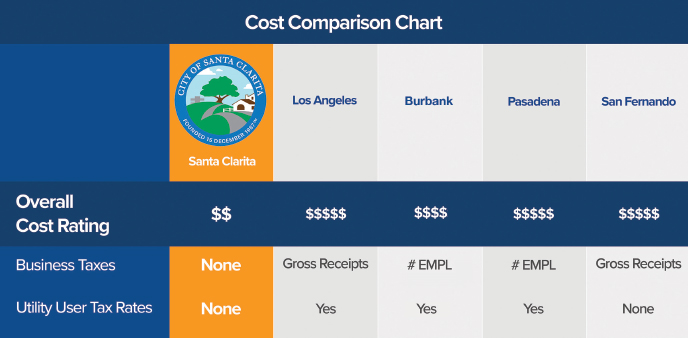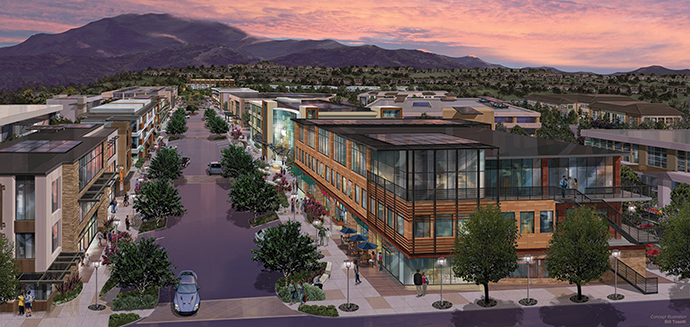Over the past decade, the Santa Clarita Valley Economic Development Corporation (SCVEDC) has led a surge of economic development in this tightly knit community 30 miles (48 km.) north of Los Angeles. By all metrics and forecasts, those ten years were merely a glimmer as to what’s on the Santa Clarita Valley’s horizon.
“We are definitely the growth area of Los Angeles County. And most of that is well-planned growth, which is one of the things that I think is very unique about the Santa Clarita Valley,” says Holly Schroeder, SCVEDC’s president and CEO.
The Santa Clarita Valley’s population is nearing 300,000, up more than six percent since 2010. In perhaps the most telling measure of the SCV’s projected emergence, developers are prepared to deliver 30,000 new homes in the coming decades. The acceleration of housing is projected to result in continued population growth, which will help meet the demand of a vibrant jobs base that has surged by a staggering 25% since 2010, outpacing the growth of the SCV’s population.

“We are definitely the growth area of LosAngeles County.”
Already, the Santa Clarita Valley has positioned itself as the lower-cost, higher-quality option for businesses in Southern California, which has made the SCV an increasingly attractive hub for technology innovation, advanced manufacturing, information technology, professional services and film and digital entertainment. SCVEDC has been at the center of shaping the pro-business environment that has fostered the region’s rise.
“EDC has established itself as a very, very credible and capable partner,” says Brian O’Connor, vice president of communications for Princess Cruises, Santa Clarita’s largest employer.
An aggressive approach to economic development has helped lure businesses from other parts of greater Los Angeles, including Logix Federal Credit Union, soon to relocate from Burbank. Logix chose the Santa Clarita Valley after getting “the red carpet treatment” from SCVEDC, says Ana Fonseca, Logix CEO.
“Holly and her team have been super, super, super supportive of us. They get very involved with helping the employers in the Santa Clarita Valley and future employers going in to make sure that they’re successful,” Fonseca tells Site Selection.
As ever, economic development is a team sport, one that yields steady dividends when local leaders can be persuaded to work toward a common vision. It’s a formula that has worked well for the Santa Clarita Valley during SCVEDC’s first decade.
“We bring together municipal players, the city and the county, academic players and the private sector business community to work collectively for economic development,” says Schroeder. “Our first ten years demonstrates that collaboration and integrated approach work and will continue to move the community forward.”
10 Things You Need to Know About The Santa Clarita Valley
1. Land is Abundant.
Ana Fonseca of Logix says the company’s decision to move to the Santa Clarita Valley hinged largely on the SCV’s supply of available commercial property.
“It was important for us to keep our workers all under one roof, and given our growth, we couldn’t do that in Burbank.”
Logix is building out a 14 acre (5.6 hectare) campus that could eventually employ as many as 1,200 people.
Added to its 29 million sq. ft. (2.7 million sq. m.) of industrial and business parks, the Santa Clarita Valley has under construction some 850,000 sq. ft. (80,000 sq. m.) of industrial building space, 265,000 sq. ft. (25,000 sq. m.) of office space, and 117,000 sq. ft. (11,000 sq. m.) of retail space, according to California Economic Forecast.
“The big advantage to the Santa Clarita Valley is that there are significant areas open for new development,” says John Balestra, principal of nationally prominent developer Trammel Crow Company.
Trammel Crow, backed by Clarion Partners, has just completed the $100 million Phase I of The Center at Needham Ranch, a 135 acre (55 hectare), master-planned business park considered to be the most significant industrial project in all of Los Angeles County. Split across six buildings of Class-A industrial space, Phase I totals 900,000 sq. ft. (85,000 sq. m.) suitable for distribution, manufacturing, research and development and corporate office uses. Phase II, says Balestra, will break ground soon.
2. New Housing is on the Way. Lots of It.
In a state where a shortage of housing has reached crisis proportions, the Santa Clarita Valley is a breathtaking exception.
“We’re going to have a continual supply of new residential construction for probably the next 20 years,” says SCVEDC’s Schroeder. “People hear that,” she says, “and their jaws drop.”
With projects underway across the region, 10,000 new homes are forecast to hit the market by 2024 alone. Newly-named Valencia, first known as Newhall Ranch, is positioned to become the biggest and most sustainable master-planned development in the country. Covering 15,000 acres (6,070 hectares), Valencia is conceived to be carbon neutral. Its 21,500 solar-powered homes each will come equipped for electric vehicle charging. With construction having launched in 2017, the first new energy-efficient homes are being built in 2020.
At full buildout, Valencia could house as many as 65,000 new residents among business parks, retail and commercial space, schools and fire stations, 10,000 acres (4,050 hectares) of open space and 50 miles (80 km.) of trails. Developer FivePoint promises 11.5 million sq. ft. (1 million sq. m.) of job generating facilities capable of creating 75,000 permanent jobs.
Vista Canyon, a project of long-time SCV developer JSB Development, is another city within a city nearing fruition. Vista Canyon is designed as a pedestrian-friendly, “car optional” community of 1,100 new homes with abundant space for office, entertainment and retail.
“It’s an urban project within a suburban setting,” says JSB president Jim Backer of the live-work-and-play community. “We’ll have lots of outdoor spaces, but we’ll also have a main street, a central gathering spot and some six-story buildings. It’s pretty unique.”
3. The Santa Clarita Valley Offers a Robust Workforce.
Given its prime location in Southern California, the Santa Clarita Valley lies within 30 miles (48 km.) of 15 colleges and universities, which allows access to a pool of young talent that is nearly unparalleled. The Economic and Workforce Division at the College of the Canyons, a two-year institution with an enrollment of 30,000 students, works closely with hundreds of business throughout the SCV.
“Our goal,” says Jeffrey Forrest, vice president of economic and workforce development, “is to create a pipeline of qualified employees to address the ever-growing needs of the business community in the Santa Clarita area.” The skills most in demand, says Forrest, include those related to allied heath, cybersecurity, manufacturing and logistics.
4. People in the SCV Know How to Make Things.
Forrest says the Santa Clarita Valley has “well over 300 companies” involved in manufacturing, including many that serve the aerospace industry, particularly nearby Boeing, Lockheed and Northrop Grumman. Companies like Crissair, ITT Aerospace Controls, Aerospace Dynamics and PPG Aerospace and are some of the SCV’s largest employers.
Crissair, which moved to the Santa Clarita Valley in 2014 and employs 230 machinists and engineers, makes valves and other components for both military and commercial aircraft.
“Whether it’s a fixed wing, a rotary, a commercial or military aircraft, Crissair will have parts on it,” says company president Michael Alfred.
5. The Santa Clarita Valley is a Great Place to Live.
Residents of the Santa Clarita Valley use words like “friendly,” “relaxed,” “safe” and “affordable” to describe their home. Named by the National Council for Home Security and Safety as the 3rd safest city in the U.S. with a population of more than 200,000 people, Santa Clarita seems perpetually tranquil, even as it blossoms into a hub of entertainment.
“The quality of life is incomparable,” says Jeffrey Forrest, who moved to SCV from St. Louis four years ago. “You have diversity. You have businesses of every kind. You do not have to leave for anything, whether it’s medical, educational or recreational. It’s truly a remarkable place.”
6. The Santa Clarita Valley Smiles on Business.
Its lack of so-called “nuisance fees” is one of the ways that the Santa Clarita Valley truly does roll out the red carpet for business. Santa Clarita’s been crowned the most business-friendly city in Los Angeles County by the Los Angeles Economic Development Corporation.
“There’s no gross receipts tax,” says Trammel Crow’s Balestra. “That’s particularly important if you’re a large company with global sales. There are no business license fees and no utility taxes.”
It’s not a matter of nickels and dimes.
“You stack it all up,” says Balestra, “and the savings to a particular business over a ten-year period can amount to hundreds of thousands if not millions of dollars.”
7. There’s Hardly a Better Location.
The Santa Clarita Valley is far enough from the hassles of Los Angeles, yet close enough to leverage L.A.’s benefits. It’s a 45-minute drive from the SCV to LAX and half that to Burbank Airport. Six major highways are minutes away, which opens the door to a universe of consumers.
“From Needham Ranch,” says Balestra, “you’ve got access to more than five-and-a-half million people within a 30 mile (50 km.) radius. Within 45 miles (72 km.) we’ve got almost 11 million people. That provides amazing access to the consumer market.”
8. Technology is on the Move.
The Santa Clarita Valley’s strength in advanced manufacturing has set the table for other technology sectors. A growing biotechnology cluster includes Advanced Bionics and Boston Scientific, both of which are developing implant technologies at facilities in the SCV. Bioness, also in the SCV, has developed an external device to help stroke victims recover.
SCVEDC’s Schroeder says the Santa Clarita Valley’s youthful demographic fits well with its burgeoning tech culture.
“As we work on trying to attract more tech companies that are basically being priced out of the Westside of Los Angeles, we point out the demographic trends. The oldest millennials right now are getting married and having kids. Many can’t afford something on the Westside, and that’s why we’re seeing that generation increasingly move here.”

9. The SCV is “Film Friendly.”
The original Mickey Mouse Club was shot at Golden Oak Ranch, one of the many film studios and movie ranches to inhabit the Santa Clarita Valley. Now, with the onset of the lucrative era of video on demand, the SCV’s early backing of the entertainment industry is reaping massive rewards.
“It is a very dynamic industry and a great multiplier,” says Schroeder. “The need for programming keeps growing. We’ve seen a 50% increase in soundstages in the past two years.”
Owing to the SCV’s abundant open space and diverse landscapes, Santa Clarita Studios, LA North Studios, Rancho Deluxe, Blue Cloud Studios, Valencia Studios and others can be configured to match environments from the Middle East to Main Street America. Movie ranches cover 3,500 acres (1,400 hectares).
“Santa Clarita has put a lot of thought into attracting filming into this area,” says Mark Horowitz, executive producer of the long-running series, NCIS. “It truly is a film-friendly community.”
10. Bottom Line: It’s the Place to Relocate.
Companies that have found new homes in the Santa Clarita Valley come from some of the most sought-after sectors of economic development, including finance (Logix, Merrill Lynch, Mercury Insurance, Morgan Stanley); advanced manufacturing (Crissair, ITT Aerospace Controls, ASC Process Systems, LA Turbine, Air Flow Research); and technology (Advanced Bionics, Scorpion, WayForward, Stratasys Direct).
The common thread among them is the desire for a home that roots for their success. SCVEDC’s Schroeder views the SCV as a “last line of defense” for companies that might otherwise flee California.
“As the fifth-largest economy in the world, California can’t be ignored. For those companies seeking access to its innovation, talent, research and market, the SCV is the best option. We’re helping businesses stay and grow in Los Angeles County.”

This Investment Profile was prepared under the auspices of Santa Clarita Economic Development Corporation. For more information, contact Holly Schroeder at (661) 288-4400, or visit scvedc.org.

